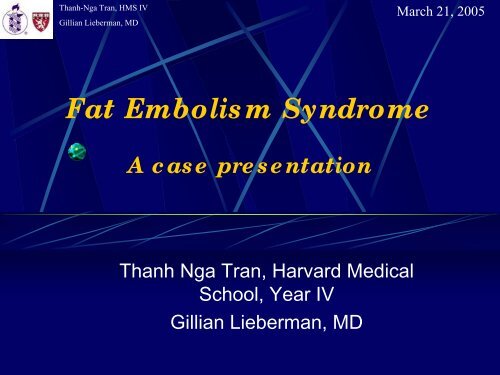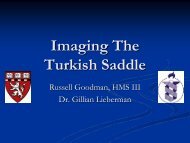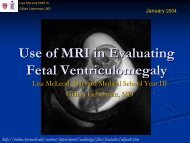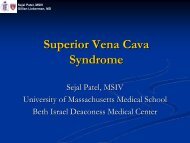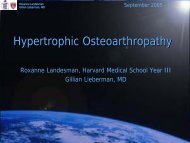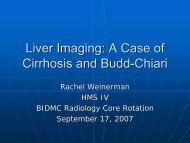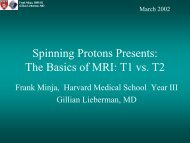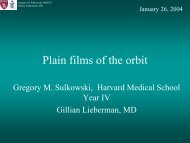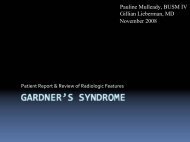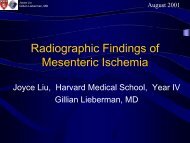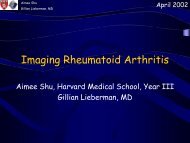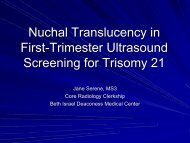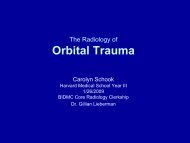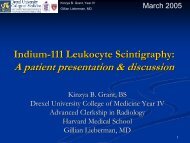Create successful ePaper yourself
Turn your PDF publications into a flip-book with our unique Google optimized e-Paper software.
Thanh-Nga Tran, HMS IV<br />
Gillian Lieberman, MD<br />
<strong>Fat</strong> <strong>Embolism</strong> <strong>Syndrome</strong><br />
A case presentation<br />
Thanh Nga Tran, Harvard Medical<br />
School, Year IV<br />
Gillian Lieberman, MD<br />
March 21, 2005
Thanh-Nga Tran, HMS IV<br />
Gillian Lieberman, MD<br />
Our Patient<br />
H.K is a 58 year-old woman with a history of<br />
afib on amiodarone, HTN, CAD, DM, high<br />
chol, s/p gastric bypass presented 2/3/2005<br />
after a mechanical fall.<br />
Pt slipped on hardwood floor. Had right distal<br />
femur comminuted fracture.<br />
She was admitted to the orthopedics service,<br />
OR on 2/4/2005 for ORIF of her right<br />
femur.<br />
Pre-operatively, pt had intact mental status<br />
and moved all extremities well.
Thanh-Nga Tran, HMS IV<br />
Gillian Lieberman, MD<br />
Comminuted fracture of<br />
the distal right femur<br />
with approximately 5<br />
mm of foreshortening,<br />
and anterior distraction.<br />
Calcifications in distal<br />
femur & proximal tibia:<br />
Evidence of old<br />
endochondromas<br />
Plain Film of the Femur<br />
PACS, BIDMC
Thanh-Nga Tran, HMS IV<br />
Gillian Lieberman, MD<br />
Femur Fracture & Enchondroma<br />
Enchondroma: Benign, no<br />
periosteal rxn, central,<br />
characteristic ring and arc<br />
calcification<br />
Ddx in long bone: bone<br />
infarction<br />
In association with<br />
pathologic fx likely<br />
enchondroma<br />
PACS, BIDMC
Thanh-Nga Tran, HMS IV<br />
Gillian Lieberman, MD<br />
Intra-operative Course<br />
Partway through, our patient acutely<br />
decompensated with SBP 60s-70s, hypoxia<br />
to 80s, end tidal CO2 37.<br />
She was started on pressors, first dopamine,<br />
then neosynephrine, then epinephrine.
Thanh-Nga Tran, HMS IV<br />
Gillian Lieberman, MD<br />
Ddx of Acute Hypoxia<br />
Pulmonary embolism from:<br />
Clot<br />
<strong>Fat</strong><br />
Air<br />
Pneumothorax<br />
Acute MI<br />
Mechanical: ET tube, machine malfunction
Thanh-Nga Tran, HMS IV<br />
Gillian Lieberman, MD<br />
Menu of Tests Available for Work-up<br />
Concern for massive PE usual work-up may<br />
include:<br />
CXR<br />
ABGs<br />
Hemodynamic monitoring<br />
Echocardiogram<br />
V/Q scan<br />
Pulmonary angiogram – gold standard<br />
Helical CT –PE protocol<br />
MRA<br />
But patient was in the O.R.
Thanh-Nga Tran, HMS IV<br />
Gillian Lieberman, MD<br />
Intra-Operative TEE<br />
Emergent intra-op Transesophageal<br />
Echocardiogram (TEE) revealed dilated RV<br />
cavity size with RV free wall hypokinesis, mild<br />
pulmonary hypertension, new PFO <br />
concerning for massive PE.<br />
Pt was given herparin initially.<br />
Emergent intra-op pulmonary arteriogram was<br />
performed.
Thanh-Nga Tran, HMS IV<br />
Gillian Lieberman, MD<br />
Intra-Operative Pulmonary Arteriogram<br />
No firm centrally-occlusive<br />
clot.<br />
Markedly decreased flow<br />
in both pulmonary arteries<br />
& no central filling defects,<br />
compatible with markedly<br />
↑↑ micro-circulatory<br />
vascular resistance.<br />
PACS, BIDMC
Thanh-Nga Tran, HMS IV<br />
Gillian Lieberman, MD<br />
Pulmonary Arteriogram<br />
Ddx includes fat embolism, air embolism,<br />
possibly extremely soft clot.<br />
Pt received Nitric Oxide (NO) for ?vasospasm<br />
with some improvement to flow<br />
Faintuch, Lang et al - Inhaled nitric oxide as an adjunct to suction<br />
thrombectomy for pulmonary embolism - J Vasc Interv Radiol. 2004<br />
Nov;15(11):1311-5.<br />
Two pts w massive PE: condition only improved after administration<br />
of NO<br />
Pt received intra-arterial tPA to both arteries<br />
for clot prevention<br />
IVC filter placed
Thanh-Nga Tran, HMS IV<br />
Gillian Lieberman, MD<br />
Post-Operative Course<br />
Pt noted to have flaccid paresis post OR<br />
and next day onset of L hemiparesis<br />
Stat head CT to r/o intracranial<br />
hemorrhage, brain infarction
Thanh-Nga Tran, HMS IV<br />
Gillian Lieberman, MD<br />
Anatomic Review of Arterial Supply to<br />
Brain<br />
www.stroke-information.net/ allcerebsupply.htm<br />
Anterior cerebral<br />
(orange)<br />
Middle<br />
cerebral (pink)<br />
Posterior<br />
cerebral (blue)
Thanh-Nga Tran, HMS IV<br />
Gillian Lieberman, MD<br />
Our Patient Head CT<br />
Temporal infarct<br />
B/l cerebellar<br />
infarcts B/l occipital (PCA<br />
territory) infarcts<br />
Diffuse hypodensity<br />
in white mater<br />
PACS, BIDMC
Thanh-Nga Tran, HMS IV<br />
Gillian Lieberman, MD<br />
Brainstem infarction<br />
Our Patient Head CT<br />
Punctated hemorrhages<br />
PACS, BIDMC
Thanh-Nga Tran, HMS IV<br />
Gillian Lieberman, MD<br />
Results of Head CT<br />
Bilateral occipital and cerebellar infarcts, &<br />
diffuse hypodensity within white mater &<br />
brainstem, likely from fat emboli.<br />
Punctate hypodensities w/in the R temporal<br />
lobe ?focal areas of petechial hemorrhage?<br />
Recommend MRI
Thanh-Nga Tran, HMS IV<br />
Gillian Lieberman, MD<br />
Our Patient MRI<br />
T1 – Image anatomy – fluid dark<br />
T2 – Image pathology – fluid bright<br />
FLAIR (Fluid-Attenuated Inversion<br />
Recovery)– Image brain pathology<br />
Edema, inflammation<br />
T2 w fluid suppressed<br />
Diffusion – sensitive for acute stroke (~<br />
Thanh-Nga Tran, HMS IV<br />
Gillian Lieberman, MD<br />
Our Patient Flair/Diffusion<br />
PACS, BIDMC
Thanh-Nga Tran, HMS IV<br />
Gillian Lieberman, MD<br />
Our Patient Flair/Diffusion<br />
PACS, BIDMC
Thanh-Nga Tran, HMS IV<br />
Gillian Lieberman, MD<br />
Our Patient Flair/Diffusion<br />
PACS, BIDMC
Thanh-Nga Tran, HMS IV<br />
Gillian Lieberman, MD<br />
Results of MRI<br />
There are multiple areas of increased<br />
T2/FLAIR/DWI signal in L occipital, temporal,<br />
frontal, deep thalamic, and R temporal, occipital<br />
lobes, & R cerebellar hemisphere c/w recent<br />
infarction.<br />
Increased T2/FLAIR signal is also visualized in<br />
the pons and L midbrain, which does not<br />
demonstrate increased signal on the DWI imaging<br />
sequence.<br />
Brain edema is visualized in these areas of<br />
infarction.
Thanh-Nga Tran, HMS IV<br />
Gillian Lieberman, MD<br />
Review of Vascular Anatomy<br />
www.csuchico.edu/.../ CMSD%20320/362unit11.html<br />
www.southeastiowaopenmri.com/ Clinical_Photos.htm<br />
www.gehealthcare.com/. ../os_images.html
Thanh-Nga Tran, HMS IV<br />
Gillian Lieberman, MD<br />
Our Patient MRA 2/08<br />
Signal loss in the<br />
distal portion of the left<br />
PCA, consistent with<br />
the territorial infarction<br />
seen on the brain MR.<br />
The rest of the major<br />
tributaries of the circle<br />
of Willis are patent<br />
PACS, BIDMC
Thanh-Nga Tran, HMS IV<br />
Gillian Lieberman, MD<br />
Our Patient Course<br />
EEG on 2/20/05 2/2 to R-sided<br />
weakness and inability to tolerate head<br />
CT: non-convulsive status epilepticus<br />
Repeat head CT
Thanh-Nga Tran, HMS IV<br />
Gillian Lieberman, MD<br />
Our Patient Head CT 2/21<br />
New L hemorrhagic conversion CVA w/in L<br />
occipital, temporal and parietal region<br />
PACS, BIDMC
Thanh-Nga Tran, HMS IV<br />
Gillian Lieberman, MD<br />
Our Patient Repeat Head CT 3/7<br />
PACS, BIDMC<br />
Several regions of stable, evolving infarction and<br />
hemorrhagic conversion: L occipital, R right parietal,<br />
R temporal lobe; and b/l frontal lobe infarctions.
Thanh-Nga Tran, HMS IV<br />
Gillian Lieberman, MD<br />
Our Patient Course<br />
Pt is s/p ORIF w fat emboli to lungs, brain through<br />
PFO, hemorrhagic conversion of CVA and<br />
subsequent non-convulsive status epilepticus<br />
(treated).<br />
Pt also had NSTEMI, line sepsis, respiratory failure<br />
and hypotension (could be 2/2 to aspiration<br />
pneumonitis or PNA), and acute renal failure.<br />
Pt is non-responsive, occasional grimace.<br />
Pt currently still in MICU. Supportive care given to<br />
family for the tragic complication.
Thanh-Nga Tran, HMS IV<br />
Gillian Lieberman, MD<br />
<strong>Fat</strong> <strong>Embolism</strong> <strong>Syndrome</strong><br />
(FES)<br />
First described by Zenker and later Von Bergmann in mid<br />
1800s<br />
Mortality 5-15%<br />
Frequently assoc with long bone/pelvic fractures, more<br />
frequent w closed fx; orthopedics surgeries, liposuction,<br />
burns, soft tissue injuries<br />
Non-trauma: pancreatitis, DM, osteomyelitis, bone tumor<br />
lysis, steroids, fatty liver, cyclosporin, lipid infusion<br />
FES typically manifests 12 to 72 hours after the initial<br />
insult or as late as two weeks
Thanh-Nga Tran, HMS IV<br />
Gillian Lieberman, MD<br />
FES<br />
Classic triad: hypoxemia; neurologic abnormalities; and<br />
a petechial rash (pathognomonic)<br />
Early findings: dyspnea, tachypnea, and hypoxemia<br />
Neurological abnl often followed: confusional state, delta<br />
MS, occasional seizures and focal deficits<br />
Late: possible petechial rash of head, neck, anterior<br />
thorax, subconjunctiva, and axillae – resolved in 5-7<br />
days<br />
Minor: lipiduria, scotomata (Purtscher's retinopathy),<br />
fever, coag abnl, myocardial depression: 2/2 to toxic<br />
mediators or dysfunctional lipid metabolism
Thanh-Nga Tran, HMS IV<br />
Gillian Lieberman, MD<br />
FES<br />
Nastanski et al J trauma, Injury, Infection, Critical Care, 2005, 374.<br />
Gurd credited w<br />
scoring system
Thanh-Nga Tran, HMS IV<br />
Gillian Lieberman, MD<br />
FES Etiology<br />
Mechanical: Occlusion of blood vessels by fat globules<br />
from trauma (marrow, adipose)- With continued<br />
embolization, pulmonary artery and right heart<br />
pressures rise PFO systemic circulation <br />
paradoxical embolism.<br />
Biochemical: Via toxic intermediates of plasma-derived<br />
fat such as chylomicrons or infused lipids: embolized fat<br />
free fatty acids (FFA) directly toxic to<br />
pneumocytes and capillary endothelium in the lung,<br />
causing interstitial hemorrhage, edema and chemical<br />
pneumonitis; also cardiac contractile dysfx.
Thanh-Nga Tran, HMS IV<br />
Gillian Lieberman, MD<br />
Clinical presentation<br />
Radiologic:<br />
Diagnosis<br />
CXR: nl in most, minority w evenly distributed, fleck-like<br />
pulmonary shadows (Snow Storm appearance), increased pulm<br />
markings and R heart dilatation<br />
V/Q: mottled pattern of subsegmental perfusion defects with a<br />
normal ventilatory pattern<br />
Chest CT: Focal areas of ground glass opacification with<br />
interloblar septal thickening<br />
Brain MRI: may reveal high intensity T2 signal, mult scattered<br />
lesions in white mater & ischemia on DWI & FLAIR<br />
PET scanning: cerebral blood flow alterations & correction<br />
No reliable lab tests
Thanh-Nga Tran, HMS IV<br />
Gillian Lieberman, MD<br />
Starfield pattern of<br />
scattered white spots<br />
pathognomonic for<br />
acute microinfarctcs.<br />
High intensity = edema<br />
Ddx: diffuse axonal<br />
injury, edema w<br />
microinfarcts, gliosis,<br />
demyelinating disease<br />
Radiology FES - MRI<br />
Patient 2<br />
DWI<br />
T2<br />
Parizel et al Stroke. 2001, p 2042
Thanh-Nga Tran, HMS IV<br />
Gillian Lieberman, MD<br />
Radiology FES - MRI<br />
Patient 3 Patient 4<br />
Multiple focal lesions in<br />
periventricular, deep,<br />
subcortical white mater –<br />
characteristic of cerebral FE<br />
Simon et al AJNR 2003; 24:97-101<br />
FLAIR<br />
FLAIR<br />
Demetriads et al Arch Surg 2004; 139, 1257
Thanh-Nga Tran, HMS IV<br />
Gillian Lieberman, MD<br />
Radiology FES -MRI<br />
T2 FLAIR<br />
Nastanski et al J trauma, Injury, Infection, Critical Care, 2005, 374.<br />
Patient 5: Post-traumatic paradoxical fat embolism to<br />
brain
CT<br />
Thanh-Nga Tran, HMS IV<br />
Gillian Lieberman, MD<br />
FES – Pulmonary CT<br />
Patient 6 - 24 yo M w comminuted<br />
femur fx: Geographic appearance<br />
of diffuse ground-glass opacities<br />
Malagari et al Chest 2003, 1196<br />
Patient 7 - 19 yo M 2 days after<br />
femur fx: ground glass opacities w<br />
smooth & nodular septal thickening
Thanh-Nga Tran, HMS IV<br />
Gillian Lieberman, MD<br />
Treatment<br />
Early immobilization of fractures<br />
Operative correction<br />
Supportive care<br />
Maintain of intravascular volume as shock can<br />
exacerbate the lung injury. Recs albumin binds<br />
fatty acids, and may decrease the extent of lung injury<br />
Mechanical ventilation and PEEP may be required to<br />
maintain PaO2.<br />
High dose corticosteroids have been effective in<br />
preventing development of FES in several trials, but<br />
controversy still persists
Thanh-Nga Tran, HMS IV<br />
Gillian Lieberman, MD<br />
Other Unusual <strong>Embolism</strong>s
Thanh-Nga Tran, HMS IV<br />
Gillian Lieberman, MD<br />
Amniotic Fluid<br />
Patient 8: 29 yo G1P1 –<br />
still birth 3mo prior, p/w R<br />
thorax dullness. CXR c/w<br />
cystic lung mass<br />
CT – homogeneous, w air,<br />
hyperdense border, density<br />
similar to pleural effusions<br />
Kaptanoguu et al Scand Cardiovasc 1999, 117
Thanh-Nga Tran, HMS IV<br />
Gillian Lieberman, MD<br />
Patient 9: 58 yo F p/w<br />
syncope<br />
Atrial Myxoma<br />
2-D TTE : Giant myxoma in<br />
the left atrium (A). The left<br />
atrial myxoma going through<br />
the mitral valve into the left<br />
ventricle during diastole (B).<br />
Acikel et al Int J Card 2004, 325
Thanh-Nga Tran, HMS IV<br />
Gillian Lieberman, MD<br />
Myxoma Emboli<br />
Patient 10: 50 yo F w<br />
transient L arm weakness<br />
and L atrial mass c/w<br />
myxoma & meningeal<br />
metastasis<br />
Resection: low grade<br />
myxosarcoma<br />
Hirudayaraj et al Int J Card 2004, 471
Thanh-Nga Tran, HMS IV<br />
Gillian Lieberman, MD<br />
Patient 11: 60 yo M w<br />
cough, wt loss, DOE s/p<br />
Transbronchioscopy Lung<br />
biopsy<br />
Fig. 1: Well-defined,<br />
rounded foci of hypodensity<br />
in the left high frontoparietal<br />
regions suggestive of air<br />
embolism.<br />
Fig. 2: Three weeks later –<br />
b/l watershed ANCA / MCA<br />
and R MCA/PCA territory<br />
infarcts (arrows).<br />
Air Emboli<br />
Figure 1 Figure 2<br />
Shetty, P et al. Australasian radiology, 2001; 215
Thanh-Nga Tran, HMS IV<br />
Gillian Lieberman, MD<br />
Air Emboli<br />
Patient 12 Patient 13<br />
Hodics et al Neurology 2003; 60- 112<br />
Courtesy of Dr. Appignani<br />
Patient 12: 35 yo M s/p lung resection for aspergilloma, tension<br />
pneumothorax s/p chest tube sudden delta MS, L face, arm, leg<br />
weakness<br />
CT: hypointensity in R MCA c/w air<br />
MRI – DWI – increased signal intensity in R MCA territory<br />
Patient 13: a more dramatic case of air embolism
Thanh-Nga Tran, HMS IV<br />
Gillian Lieberman, MD<br />
Methacrylate Emboli<br />
Patient 14: 54 yo M s/p<br />
vertebroplasty for mets esophageal<br />
CA with abnl CXR<br />
CT: Mid to distal pulmonary<br />
vessels dense material c/w<br />
metacrylate emboli.<br />
PACS, BIDMC<br />
Distal to the metacrylate: the<br />
pulmonary vessels are low<br />
density c/w lack of perfusion
Thanh-Nga Tran, HMS IV<br />
Gillian Lieberman, MD<br />
References<br />
Up-to-date: http://www.uptodate.org<br />
Odegard, K. <strong>Fat</strong> <strong>Embolism</strong>: Diagnosis and Treatment.<br />
http://www.orthoteers.co.uk/Nrujp~ij33lm/Orthfatembolism.htm<br />
www.stroke-information.net/ allcerebsupply.htm<br />
Parizel, PM et al. Early diagnosis of cerebral fat embolism syndrome by<br />
diffusion-weighted MRI (Starfield pattern). Stroke 2003; 2942.<br />
Demetriades, D et al. Image of the month. Arch Surg 2004; 139, 1257.<br />
Prologo, JD et al. CT diagnosis of cerebral fat embolism. Am J<br />
Emergency Medicine 2004; 22(7), 605.<br />
Simon, AD et al. Contrast-enhanced MR imaging of cerebral fat<br />
embolism: Case report and review of literature. Am J Neuroradiol, 2003;<br />
24:97-101.<br />
Nastanski, F et al. Posttraumatic paradoxical fat embolism to the brain: A<br />
case report. J of Trauma Injury, Infection, Critical Care, 2005; 58(2), 372<br />
Malagari, K et al. High resolution CT findings in mild pulmonary fat<br />
embolism. Chest 2003; 123(4): 1196.
Thanh-Nga Tran, HMS IV<br />
Gillian Lieberman, MD<br />
References<br />
Kaptanoguu et al. Lung mass due to amniotic fluid embolism. Scand<br />
Cardiovasc J 1999; 33, 117.<br />
Acikel M et al. A giant left atrial myxoma: an unusual cause of syncope<br />
and cerebral emboli. Int J of Card 2004; 94, 325.<br />
Hirudayaraj, P et al. Myxomatous meningeal tumor: a case of<br />
“metastaic” cardiac myxoma. Int J Card 2004; 96: 471.<br />
Shetty, PG et al. <strong>Fat</strong>al cerebral air embolism as a complication of<br />
transbronchoscopic lung biopsy: a case report. Australasian Radiology<br />
2001; 45: 215.<br />
Hodics et al. Cerebral air embolism. Neurology 2003;60: 112-145.
Thanh-Nga Tran, HMS IV<br />
Gillian Lieberman, MD<br />
Acknowledgements<br />
Barbara Appignani, MD<br />
Larry Barbaras<br />
Daniel Cornfield, MD<br />
Elvira Lang, MD<br />
Pamela Lepkowski<br />
Gillian Lieberman, MD<br />
Phoebe Olhava, MD<br />
Jesse Wei, MD


